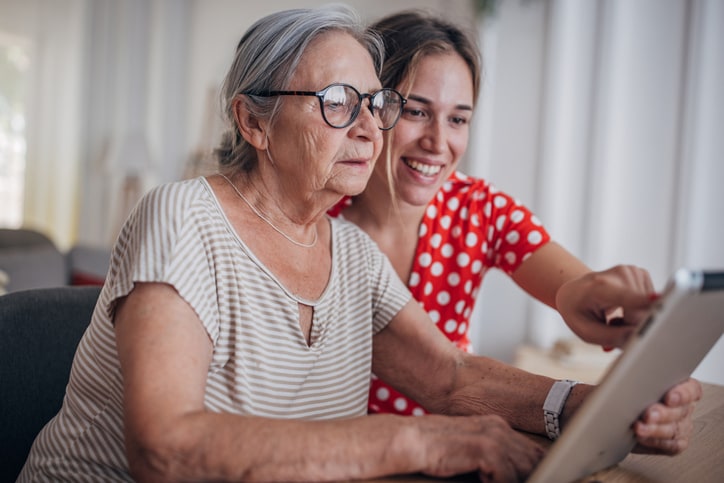In this article
Caregiving for aging parents is stressful enough, but when you’re an only child, the stress is that much greater. That’s because you’re 100% responsible for the mental and emotional load of caregiving, in addition to any care responsibilities you might have. Caregiving for aging parents as an only child can be challenging, but there are things you can do to cope, and support is out there for you.
For solo caregivers, prioritizing your own needs is non-negotiable. “You cannot provide good care to someone else if you aren’t caring for yourself,” says Dr. Carli Carnish, a doctor of nursing practice and assistant professor of aging and health at Case Western Reserve University. “Think of the airplane safety warnings — you should always put your own mask on first before trying to help others.”
Here, we’ll cover how to take care of your own needs while caring for your aging parents, as well as other essential tips for managing elder care as an only child.
Key takeaways
- Only-child caregivers handle the complete emotional, mental and physical toll of caregiving. This can make them more vulnerable to caregiver burnout, isolation and stress.
- Coping with the challenges of only-child caregiving involves creating your own “care circle” of friends, neighbors and even hire care help who can share the burden and offer you support. Additionally, take microbreaks (short breaks to recharge throughout the day) and prioritize social contact.
- Sometimes professional help may be needed, such as support from a geriatric care manager or licensed therapist. You can also utilize respite care. There is no shame or failure in asking for help when you need it.
What are the biggest challenges of being an only-child caregiver?
Being an only-child caregiver can be a difficult, lonely and isolating experience. “Only-child caregivers are unable to share the responsibility of caring for a parent with siblings,” Carnish says. “This is challenging physically, but also emotionally and mentally draining.”
The mental load of solo caregiving
Probably the biggest challenge for only-child caregivers is the fact that they must carry the full emotional and decision-making load all by themselves, says Dr. L. Grant Canipe, assistant clinical psychology professor at The Chicago School.
“They are going to be the default everything: planner, companion, problem-solver, etc.,” he says. This kind of pressure and responsibility can lead to things like decision fatigue and isolation. “When the really tough choices inevitably show up, like when to transition to assisted living, the lack of siblings will likely make those decisions feel quite lonely and overwhelming.”
Caregiver burnout
Only-child caregivers may be more prone to caregiver burnout than caregivers who have siblings to help. “Caregiver burnout is a particular risk for an only-child, as sharing of responsibilities with another caregiver (such as a sibling) is not possible,” says Dr. Carrie Ditzel, director of clinical health and geropsychology at Baker Street Behavioral Health.
Caregiver burnout isn’t always easy to recognize. “A first sign that you need more help is when a caregiver finds they’re putting off their own needs, such as doctors appointments, or have little to no contact with others besides their loved one,” Ditzel shares. Burnout might also look like resentment or anger toward a loved one, or finding that your usual methods for de-stressing just aren’t working at all, Ditzel adds.
“Just because you don’t have siblings doesn’t mean you can’t have a team. Friends, cousins, faith communities, neighbors and even hired companions can help you and your parent in small but meaningful ways.”
— Dr. L. Grant Canipe, assistant clinical psychology professor
How do you cope as an only-child caregiver?
Recognizing you are experiencing loneliness, burnout or overwhelm as an only-child caregiver is an important first step. Just as important, though, is learning to cope with the burden you are experiencing. Here are some expert-driven tips to do just that.
1. Take microbreaks
If you are in the throes of elder caregiving as an only-child, you likely don’t have time for a week-long vacation or a spa day. But you do have time for smaller microbreaks, and you should prioritize these whenever possible, Canipe recommends. What is a microbreak? Here are some suggestions from Canipe:
- A three-minute walk outside without looking at your electronic device.
- Two minutes of deep, intentional breathing before walking inside or taking a care-related phone call.
- Putting on your headphones and listening to your favorite song while your loved one naps.
2. Prioritize social contact
Canipe recommends scheduling social contact the same way you schedule a doctor’s appointment. In other words, make social contact a priority. “Your loneliness acts as a biological stressor, raising cortisol levels and causing inflammation,” he explains.
His suggestion is to plan one non-caregiver social interaction each week. “It doesn’t have to be complicated or heavily involved — consider joining a book club, an online support group or even taking your dog to the park to meet new people and enjoy some scratches,” he says.
Moti Gamburd, CEO of CARE Homecare, a California home care agency specializing in Alzheimer’s and dementia care, suggests looking for “quick connections” to keep isolation and loneliness at bay. “A two-minute text check-in, greeting the neighbor or making a quick phone call is enough that you feel like you’re still connected with the world outside the caregiving bubble,” he explains.
3. Name your stress
It’s not just being aware of your only-child caregiver stress that can be helpful, but also labeling and naming it, says Canipe. “The brain’s stress circuits have been shown to ‘calm’ when you label the emotions,” he explains, noting that professionals call this “affect labeling.”
“This practice fosters emotional literacy, making intense or overwhelming feelings easier to manage and enhancing the ability to tolerate emotional experiences and respond adaptively to situations,” he adds.
Once you can identify the patterns, you can make small, targeted changes. “Some examples I’ve seen include shifting a phone call with a parent or a callback to a doctor to a less hectic time of day or part of the week,” Canipe shares.
4. Engage in back-to-basics self-care
There’s no way around it: you’ve got to take care of yourself, because you can’t be the caregiver your parent needs without being healthy yourself.
“The aging researcher in me must mention the numerous positive effects of getting 7-8 hours of sleep, eating a balanced diet and staying active daily,” Canipe explains. “Exercise and sleep promote synaptogenesis and neurogenesis, which is our ability to adapt to stress.”
Where can you find support as a solo caregiver?
Just because you’re an only child doesn’t mean you have to do this alone. “Solo caregiving doesn’t mean solitary caregiving,” Canipe emphasizes. Here are some expert-backed ideas for how to build a team of support so that you can continue to give your loved one the care they need without sacrificing your own well-being.
Create your own “care circle”
“Just because you don’t have siblings doesn’t mean you can’t have a team,” says Canipe, who recommends putting together your own care team. “Friends, cousins, faith communities, neighbors and even hired companions can help you and your parent in small but meaningful ways.”
The key here is being direct with your care team about what you need. For example, if you need caregiving help, you could contact someone on your team and say something like: “Could you plan to visit on Friday afternoon so I can schedule an appointment and run some errands?”
“If you’re wondering whether you need help, that’s usually a sign that you already do. The sooner you reach out — even for small supports — the better you can protect your own health and ability to care.”
— Dr. L. Grant Canipe
Reach out to a geriatric care manger
Geriatric care managers (also called Aging Life Care Managers) are professionals — usually social workers or nurses — who have special training in helping families navigate senior care.
“These professionals are trained in being a ‘player’ on the caregiver team with a variety of roles,” Ditzel says. “I have seen caregivers and patients thrive with having a care manager assist with making doctors appointments, managing the coordination of medical care among providers and connecting patients and caregivers to referrals for services as they become necessary.”
You can use
Who can you turn to for advice and help finding resources for your loved one?
As you gather resources for help and support, Ditzel recommends starting with a parent’s primary care provider. “Nearly every practice has a case manager or licensed social worker who is familiar with area resources,” she says. “There are also support groups specifically for caregivers, many of which now are offered virtually.”
Your primary care office may also be able to help you connect with respite care providers, such as adult daycare or facility-based short-term care, which are programs where you can drop off a loved one temporarily so that they can receive meals, care and participate in activities.
Read more:
How do you know when it’s time to ask for help?
The clearest sign that it’s time for you to get some help as a caregiver is when you begin to find it hard to function in your day-to-day life. “If you notice that you’re constantly exhausted, snapping at loved ones, losing interest in activities that once helped you feel better, or feeling anxious, tearful or numb most of the time — those are warning signs from your brain and body,” says Canipe.
Another red flag? It’s when you skip your own medical appointments, stop sleeping or begin to feel unsafe driving or managing medications because you’re so drained, Canipe notes. “Those are strong signs that your bandwidth has been overwhelmed — and that’s precisely when outside support can make the most significant difference.”
If this is you, Canipe recommends the following resources to turn to for support:
- Check your local Area Council on Aging or visit 211.org. They can connect you to respite services, caregiver grants or volunteer companions.
- Ask faith communities and neighborhood groups. They can offer support and ideas for local resources.
- Consult a therapist. Many provide sliding-scale fees or telehealth options that are more budget-friendly.
- Find support groups (in person or online). These can provide emotional relief and practical advice in an informal setting.
- Check your local university psychology or social work departments. If you’re in need of mental health support for yourself but are concerned about cost, these programs may operate free or low-cost counseling clinics.
“If you’re wondering whether you need help, that’s usually a sign that you already do,” Canipe emphasizes. “The sooner you reach out — even for small supports — the better you can protect your own health and ability to care.”





